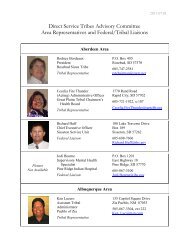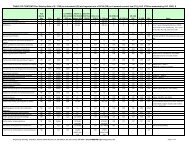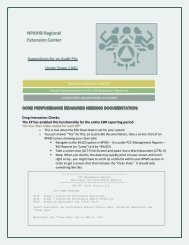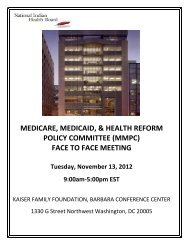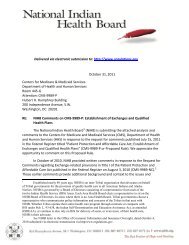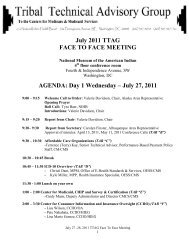âHealth Insurance Premium Tax Creditâ (IRS REG-131491-10)
âHealth Insurance Premium Tax Creditâ (IRS REG-131491-10)
âHealth Insurance Premium Tax Creditâ (IRS REG-131491-10)
- No tags were found...
You also want an ePaper? Increase the reach of your titles
YUMPU automatically turns print PDFs into web optimized ePapers that Google loves.
NIHB Supplemental Submission - Definition of IndianBoth the IHCIA and the ISDEAA were crafted under the broad national policy offulfilling the special trust responsibility of the United States to Indians and Indian selfdetermination,and in contrast to the policy of termination. The authors of these lawsexplicitly required efforts to encourage the maximum participation of Indian people in themanagement and operation of Indian benefits and programs.3.1.4 The Courts Have Interpreted the Definitions of Indian to IncludePeople Who Are Not Members of Tribes.Courts have specifically held that the definition of Indian found in the IHCIAand ISDEAA is not limited to members of Federally-recognized Tribes. For example,courts have specifically held that this definition can under some circumstancesinclude state-recognized tribes 38 and, in certain cases, even entities that are noteligible for special programs. 39Moreover, an individual need not be enrolled in a tribe under certaincircumstances to qualify as an ―Indian‖ under the ISDEAA. At least one court hasheld that the phrase ―other organized group or community‖ in the ISDEAA definitionof ―Indian tribe‖ refers to a geographic area within which a tribe is located so long asIndians in that community receive federal, Indian-specific assistance. 40 Because thestate-recognized tribe at issue was located within the geographic area that receivedIHS services from an urban Indian organization, it was part of a ―community‖ thatwas ―recognized as eligible for the special programs and services provided by theUnited States to Indians because of their status as Indians.‖ As such, it fell within theISDEAA definition.The court supported this analysis by examining the purposes of the ISDEAA,the IHCIA, and federal precedents. 41 The court found that ―to conclude that [anindividual who is] a member of the recipient Indian community, cannot qualify for anIndian preference would be contrary to the meaning of the Indian preference law andthe rationale of the United States Supreme Court.‖ 42 This interpretation of the phrase―other organized group or community‖ is correct as it ensures that individuals ofIndian descent who live within an overall tribal community, but who are not membersof an Indian tribe, be considered ―Indians‖ for the purposes of the ACA.Secretary. See, IHCIA § 4(28), 25 U.S.C. § 1603(28), in which references to subsections (g) ―urbancenter‖ and (c) ―Indians or Indian‖ of the IHCIA were redesignated as paragraphs (27) and (13),respectively, by Section <strong>10</strong>4(3) of S. 1790 as reported by the Senate Committee on Indian Affairs(―SCIA‖), which was incorporated by reference into the ACA pursuant to § <strong>10</strong>221.38 Schmasow v. Native Am. Ctr., 968 P.2d 304 (Mont.1999).39 Cook Inlet Native Ass’n v. Bowen, 8<strong>10</strong> F. 2d 1471, 1474 (9th Cir. 1987).40 Schmasow, 978 P.2d at 304.41 Id. at 308.42 Id. (emphasis added).National Indian Health Board Page <strong>10</strong> of 24 October 31, 2011




